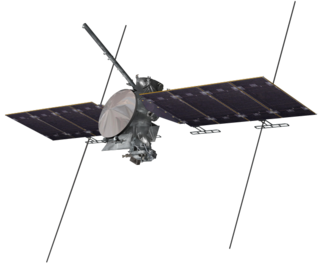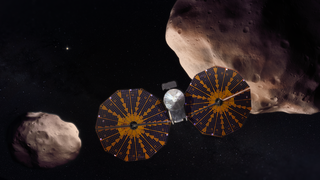Related Research Articles

The Discovery Program is a series of Solar System exploration missions funded by the US National Aeronautics and Space Administration (NASA) through its Planetary Missions Program Office. The cost of each mission is capped at a lower level than missions from NASA's New Frontiers or Flagship Programs. As a result, Discovery missions tend to be more focused on a specific scientific goal rather than serving a general purpose.
Mantis is the common name of any insect in the order Mantodea, also commonly known as praying mantises.

Observations of the planet Venus include those in antiquity, telescopic observations, and from visiting spacecraft. Spacecraft have performed various flybys, orbits, and landings on Venus, including balloon probes that floated in the atmosphere of Venus. Study of the planet is aided by its relatively close proximity to the Earth, compared to other planets, but the surface of Venus is obscured by an atmosphere opaque to visible light.
The New Frontiers program is a series of space exploration missions being conducted by NASA with the purpose of furthering the understanding of the Solar System. The program selects medium-class missions which can provide high science returns.

101955 Bennu (provisional designation 1999 RQ36) is a carbonaceous asteroid in the Apollo group discovered by the LINEAR Project on 11 September 1999. It is a potentially hazardous object that is listed on the Sentry Risk Table and has the highest cumulative rating on the Palermo Technical Impact Hazard Scale. It has a cumulative 1-in-1,800 chance of impacting Earth between 2178 and 2290 with the greatest risk being on 24 September 2182. It is named after the Bennu, the ancient Egyptian mythological bird associated with the Sun, creation, and rebirth.
Io Volcano Observer (IVO) is a proposed low-cost, outer-planet mission to explore Jupiter's moon Io to understand tidal heating as a fundamental planetary process. The main science goals are to understand (A) how and where tidal heat is generated inside Io, (B) how tidal heat is transported to the surface, and (C) how Io is evolving. These results are expected to have direct implications for the thermal history of Europa and Ganymede as well as provide insights into other tidally heated worlds such as Titan and Enceladus. The IVO data may also improve our understanding of magma oceans and thus the early evolution of the Earth and Moon.

NEO Surveyor, formerly called Near-Earth Object Camera (NEOCam), then NEO Surveillance Mission, is a planned space-based infrared telescope designed to survey the Solar System for potentially hazardous asteroids.
The Asteroid Impact and Deflection Assessment (AIDA) missions are a proposed pair of space probes which will study and demonstrate the kinetic effects of crashing an impactor spacecraft into an asteroid moon. The mission is intended to test and validate impact models of whether a spacecraft could successfully deflect an asteroid on a collision course with Earth.

Europa Clipper is an interplanetary mission in development by NASA comprising an orbiter. Planned for launch in October 2024, the spacecraft is being developed to study the Galilean moon Europa through a series of flybys while in orbit around Jupiter.

Phobos And Deimos & Mars Environment (PADME) is a low-cost NASA Mars orbiter mission concept that would address longstanding unknowns about Mars' two moons Phobos and Deimos and their environment.
OKEANOS was a proposed mission concept to Trojan asteroids, which share Jupiter's orbit, using a hybrid solar sail for propulsion; the sail was planned to be covered with thin solar panels to power an ion engine. In situ analysis of the collected samples would have been performed by either direct contact or using a lander carrying a high-resolution mass spectrometer. A sample-return to Earth was an option under study.

Lucy is a NASA space probe on a twelve-year journey to eight different asteroids, visiting a main belt asteroid as well as seven Jupiter trojans, asteroids which share Jupiter's orbit around the Sun, orbiting either ahead of or behind the planet. All target encounters will be flyby encounters. The Lucy spacecraft is the centerpiece of a US$981 million mission.

A flyby is a spaceflight operation in which a spacecraft passes in proximity to another body, usually a target of its space exploration mission and/or a source of a gravity assist to impel it towards another target. Spacecraft which are specifically designed for this purpose are known as flyby spacecraft, although the term has also been used in regard to asteroid flybys of Earth for example. Important parameters are the time and distance of closest approach.

Double Asteroid Redirection Test (DART) is a NASA space mission aimed at testing a method of planetary defense against near-Earth objects (NEOs). It was designed to assess how much a spacecraft impact deflects an asteroid through its transfer of momentum when hitting the asteroid head-on. The asteroid selected for the test poses no actual threat to Earth and was selected for the convenience of the test. The probe was launched from Earth on 24 November 2021, and on 26 September 2022 intentionally crashed into Dimorphos, the minor-planet moon of the asteroid Didymos. On 11 October, NASA declared DART a success, confirming it had shortened Dimorphos' orbital period around Didymos by about 32 minutes, surpassing the pre-defined success threshold of 73 seconds.

SPRITE was a proposed Saturn atmospheric probe mission concept of the NASA. SPRITE is a design for an atmospheric entry probe that would travel to Saturn from Earth on its own cruise stage, then enter the atmosphere of Saturn, and descend taking measurements in situ.
Venus In Situ Atmospheric and Geochemical Explorer (VISAGE) is a proposed Venus lander mission that would perform atmospheric and surface science investigations.
The Mapping Imaging Spectrometer for Europa (MISE) is an imaging near infrared spectrometer on board the Europa Clipper mission to Jupiter's moon Europa. MISE will examine Europa's surface composition and relate it to the habitability of its internal water ocean.
Centaurus is a mission concept to flyby the centaurs 2060 Chiron and Schwassmann-Wachmann 1. It was submitted in response to the NASA Discovery program call for proposals in 2019 but ultimately was not among the four missions selected for further development by NASA in February 2020. If it had been selected, Centaurus would have been the first mission to attempt a flyby of a centaur.

Hera is a space mission in development at the European Space Agency in its Space Safety program. Its primary objective is to study the Didymos binary asteroid system that was impacted by DART and contribute to validation of the kinetic impact method to deviate a near-Earth asteroid in a colliding trajectory with Earth. It will measure the size and the morphology of the crater created by and momentum transferred by an artificial projectile impacting an asteroid, which will allow measuring the efficiency of the deflection produced by the impact.
References
- 1 2 3 4 "The Main-belt Asteroid and NEO Tour with Imaging and Spectroscopy (MANTIS)." Andrew S. Rivkin, Barbara A. Cohen, Olivier Barnouin, Carolyn M. Ernst, Nancy L. Chabot, Brett W. Denevi, Benjamin T. Greenhagen, Rachel L. Klima, Mark Perry, Zoltan Sternovsky, and the MANTIS Science Team. EPSC Abstracts Vol. 13, EPSC-DPS2019-1277-1, 2019 EPSC-DPS Joint Meeting 2019.
- ↑ Proposals to Explore the Solar System’s Smallest Worlds. Van Kane, The Planetary Society. 27 July 2015.
- 1 2 The Main-belt Asteroid and NEO Tour with Imaging and Spectroscopy (MANTIS). Andrew Rivkin, Barbara A. Cohen, Olivier S. Barnouin, Nancy L. Chabot, Carolyn M. Ernst, Rachel L. Klima. AGU Fall Meeting 2018. Washington DC, 10-14 December 2018.





